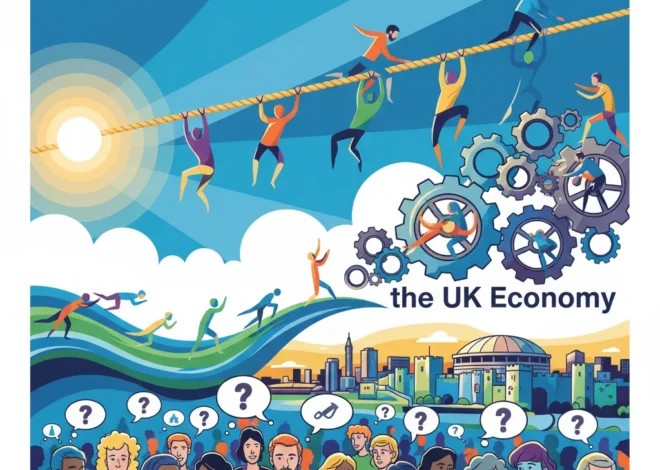
The Silent Slowdown: Why 2023’s Holiday Hiring is Flashing Red for the Economy
The festive season, typically a bustling period of opportunity for seasonal workers and a revenue gold rush for retailers, is casting a long, uncertain shadow this year. For many, the search for a holiday job is a familiar annual ritual. But this year, that search is proving fruitless for an alarming number of people. The headline-grabbing quote from one job seeker, “This is the first year I can’t find a holiday job,” isn’t just an isolated story of misfortune; it’s the canary in the coal mine for the U.S. economy.
Recent data paints a stark picture: seasonal hiring is projected to fall to its lowest point since the depths of the Great Recession in 2008. According to a report from the BBC, this dramatic pullback is a direct consequence of a potent cocktail of economic pressures, including persistent trade tariffs and palpable consumer anxiety. For investors, business leaders, and anyone with a stake in the financial markets, this trend is more than just a seasonal quirk—it’s a critical barometer of economic health and a potential harbinger of a broader slowdown.
A Chill in the Air: Unpacking the 15-Year Low
To fully grasp the gravity of the situation, we must understand the significance of the 2008 comparison. That year marked the epicenter of a global financial crisis that reshaped modern economics and banking. For hiring to retreat to those levels signifies a profound level of caution rippling through the business community. This isn’t a minor course correction; it’s a defensive maneuver in the face of mounting uncertainty.
The slowdown is not uniform, but it is widespread. Major retailers and logistics companies, the traditional engines of holiday employment, are tapping the brakes. They are navigating a complex landscape where the cost of doing business is rising, and the willingness of consumers to spend is dwindling. This cautious approach is a rational response to a trifecta of economic headwinds that are converging at the worst possible time.
The Millionaire's Gambit: Why the Super-Rich Are Demanding to Pay More Tax
1. Lingering Trade Tariffs and Supply Chain Strain
While no longer a daily headline, the impact of tariffs imposed over the last several years continues to reverberate through the global supply chain. These taxes on imported goods directly increase costs for U.S. businesses, squeezing profit margins. Companies are faced with a difficult choice: absorb the costs, which hurts their bottom line and spooks the stock market, or pass them on to consumers, which can dampen demand. This uncertainty makes it incredibly difficult to forecast holiday sales, leading many to err on the side of caution by trimming their seasonal workforce.
2. The Anxious Consumer
The American consumer, the bedrock of the U.S. economy, is feeling the pressure. After years of grappling with inflation, rising interest rates have made borrowing for everything from cars to homes more expensive. Savings rates have dwindled, and credit card debt has soared. This “consumer angst,” as the BBC article puts it, is translating into more conservative spending habits. Families are prioritizing essentials and cutting back on discretionary purchases—the very items that drive holiday sales. Businesses are acutely aware of this shift and are adjusting their staffing levels to match the anticipated dip in foot traffic and online orders.
3. The Corporate Pivot to Efficiency
In this high-cost, uncertain environment, the C-suite mantra is “efficiency.” Businesses are leveraging technology and optimizing operations to do more with less. Advances in financial technology (fintech) allow for more precise inventory management, reducing the need for excess stock and the staff to handle it. Automation in warehouses and sophisticated e-commerce platforms mean that fewer human hands are needed to fulfill orders. This isn’t just about cutting costs; it’s a strategic pivot towards a leaner, more resilient business model, a trend that investors in the finance world are rewarding.
Data-Driven Caution: A Comparative Look at Economic Pressures
To visualize the factors driving this corporate caution, let’s break down the key pressures and their direct impact on holiday hiring decisions. This is the calculus that business leaders and investors are wrestling with right now.
| Economic Pressure | Description | Impact on Seasonal Hiring |
|---|---|---|
| Elevated Interest Rates | The Federal Reserve’s policy to combat inflation has increased the cost of borrowing for both businesses and consumers. | Reduces business investment in inventory/expansion; dampens consumer spending on big-ticket items, lowering sales forecasts. |
| Inflationary Pressures | While cooling, the cost of goods, energy, and labor remains high, squeezing corporate profit margins. | Companies prioritize cost control over expanding payroll, seeking to protect their bottom line. |
| Consumer Debt Levels | Record-high credit card debt and depleted pandemic-era savings limit discretionary spending power. | Lower anticipated consumer demand leads directly to lower demand for seasonal retail and logistics staff. |
| Global Economic Uncertainty | Geopolitical conflicts and slowing growth in key international markets create an unpredictable environment. | Businesses become risk-averse, preserving capital and avoiding large-scale temporary hiring commitments. |
The Investor’s Playbook: Navigating a Tepid Holiday Season
For those involved in investing and trading, this seasonal hiring data is a crucial piece of the puzzle. It provides a real-time signal about the health of the consumer and the outlook for Q4 corporate earnings, particularly in the retail and logistics sectors. So, how should one interpret these signals?
First, expect increased volatility in consumer discretionary stocks. Companies that rely heavily on holiday sales may face downward revisions on their earnings forecasts. Investors should scrutinize balance sheets, looking for companies with low debt, strong cash flow, and efficient operations. These are the businesses best positioned to weather a consumer spending slowdown.
Second, this trend reinforces the Federal Reserve’s data-dependent stance. A weak labor market, even a seasonal one, could be a sign that the central bank’s interest rate hikes are having their intended cooling effect on the economy. This could influence future decisions on rates, a key driver for the entire stock market. The interconnectedness of labor data, monetary policy, and market performance cannot be overstated (source).
Finally, look for sectors that demonstrate resilience. While retail may struggle, other areas of the economy might hold steady. Technology companies providing efficiency solutions (including fintech and automation) may continue to thrive as businesses double down on cost-saving measures. Even within retail, discount chains may outperform luxury brands as consumers trade down.
UK Inflation Cools, But Is the Economic Winter Over? A Deep Dive for Investors and Leaders
The Future of Work and the Role of Financial Technology
This hiring slowdown also accelerates a conversation about the future of seasonal work. The gig economy and the rise of sophisticated workforce management platforms are changing the landscape. Modern financial technology gives companies the ability to scale their workforce with surgical precision, hiring workers for specific shifts or tasks rather than for an entire season. This “just-in-time” approach to labor, while efficient for businesses, creates a more precarious environment for workers seeking stable seasonal income.
Furthermore, emerging technologies like blockchain, while not yet mainstream in this context, offer a glimpse into a future of hyper-transparent supply chains. A company that can track its goods with perfect accuracy from factory to shelf can optimize inventory and logistics to an unprecedented degree, further reducing the need for a large buffer of seasonal staff. This technological march is relentless and will continue to reshape labor dynamics.
Conclusion: A Barometer for the Year Ahead
The quiet hiring floors and reduced “Help Wanted” signs this holiday season are more than just a disappointment for job seekers; they are a clear and potent economic signal. The drop in seasonal hiring to a 15-year low is a reflection of a business community bracing for impact, reacting to a cautious consumer and an uncertain global stage. For investors and financial professionals, this is a time for diligence and a focus on resilience over speculative growth.
This slowdown serves as a powerful reminder that the macro-economy is an intricate web where corporate strategy, consumer confidence, and global events are deeply intertwined. As we move into the new year, the data that emerges from this muted holiday season will be critical in shaping the economic narrative and guiding investment strategies for 2024 and beyond.


